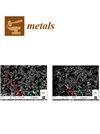利用相关方法结合深度学习技术对高度复杂微结构的光学显微图像进行高效相位分割
IF 2.5
3区 材料科学
Q3 MATERIALS SCIENCE, MULTIDISCIPLINARY
引用次数: 0
摘要
可靠的微观结构表征对于建立工艺-微观结构-性能之间的联系和有效的质量控制至关重要。传统的人工微观结构分析通常在客观性、可重复性和可扩展性方面存在困难,尤其是在复杂材料中。机器学习方法提供了一种很有前途的替代方法,但却受到分配准确一致的基本事实这一挑战的阻碍,尤其是对于复杂的微观结构而言。本文介绍了一种使用相关显微镜--结合光学显微镜、扫描电子显微镜和电子反向散射衍射(EBSD)--为机器学习训练创建客观、可重复的逐像素注释的方法。通过半自动化的方式,基于 EBSD 的注释被用于生成客观的基本真实掩膜,以训练用于量化简单光学显微照片的语义分割模型。训练掩模是利用现代深度学习方法从原始 EBSD 数据中直接得出的。通过使用基于 EBSD 的注释(其中包含晶体学和错误取向数据),可以确保训练掩膜创建的正确性和客观性。最终方法能够在复杂淬火钢的光学显微照片中重复、客观地区分贝氏体和马氏体。通过将微观结构评估简化为光学显微照片这种最简单、最广泛使用的方法,这种量化微观结构的方法具有效率高和可扩展性好的特点。本文章由计算机程序翻译,如有差异,请以英文原文为准。
Efficient Phase Segmentation of Light-Optical Microscopy Images of Highly Complex Microstructures Using a Correlative Approach in Combination with Deep Learning Techniques
Reliable microstructure characterization is essential for establishing process–microstructure–property links and effective quality control. Traditional manual microstructure analysis often struggles with objectivity, reproducibility, and scalability, particularly in complex materials. Machine learning methods offer a promising alternative but are hindered by the challenge of assigning an accurate and consistent ground truth, especially for complex microstructures. This paper introduces a methodology that uses correlative microscopy—combining light optical microscopy, scanning electron microscopy, and electron backscatter diffraction (EBSD)—to create objective, reproducible pixel-by-pixel annotations for ML training. In a semi-automated manner, EBSD-based annotations are employed to generate an objective ground truth mask for training a semantic segmentation model for quantifying simple light optical micrographs. The training masks are directly derived from raw EBSD data using modern deep learning methods. By using EBSD-based annotations, which incorporate crystallographic and misorientation data, the correctness and objectivity of the training mask creation can be assured. The final approach is capable of reproducibly and objectively differentiating bainite and martensite in optical micrographs of complex quenched steels. Through the reduction in the microstructural evaluation to light optical micrographs as the simplest and most widely used method, this way of quantifying microstructures is characterized by high efficiency as well as good scalability.
求助全文
通过发布文献求助,成功后即可免费获取论文全文。
去求助
来源期刊

Metals
MATERIALS SCIENCE, MULTIDISCIPLINARY-METALLURGY & METALLURGICAL ENGINEERING
CiteScore
4.90
自引率
13.80%
发文量
1832
审稿时长
1.5 months
期刊介绍:
Metals (ISSN 2075-4701) is an open access journal of related scientific research and technology development. It publishes reviews, regular research papers (articles) and short communications. Our aim is to encourage scientists to publish their experimental and theoretical results in as much detail as possible. Therefore, there is no restriction on the length of the papers. The full experimental details must be provided so that the results can be reproduced. Metals provides a forum for publishing papers which advance the in-depth understanding of the relationship between the structure, the properties or the functions of all kinds of metals.
 求助内容:
求助内容: 应助结果提醒方式:
应助结果提醒方式:


